A Continuously Tunable Full-Color Emission Nitrogen-Doped Carbon Dots and for Ultrasensitive and Highly Selective Detection of Ascorbic Acid
Abstract
:1. Introduction
2. Materials and Methods
2.1. Chemicals and Reagents
2.2. Synthesis of F-NCDs
2.3. Characterization of F-NCDs
2.4. Detection of AA
3. Results and Discussion
3.1. Characterization of F-NCDs
3.2. Optical Characteristics of F-NCDs
3.3. Full-Color Emission Mechanism of F-NCDs
3.4. Application of F-NCDs
3.4.1. Stability of F-NCDs
3.4.2. Detection of Ascorbic Acid (AA)
3.4.3. Mechanism for Ascorbic Acid (AA) Detection
3.4.4. Detection of Ascorbic Acid (AA) in Bovine Serum
4. Conclusions
Author Contributions
Funding
Institutional Review Board Statement
Informed Consent Statement
Data Availability Statement
Acknowledgments
Conflicts of Interest
References
- Mohammadinejad, R.; Dadashzadeh, A.; Moghassemi, S.; Ashrafizadeh, M.; Dehshahri, A.; Pardakhty, A.; Sassan, H.; Sohrevardi, S.-M.; Mandegary, A. Shedding light on gene therapy: Carbon dots for the minimally invasive image-guided delivery of plasmids and noncoding RNAs. J. Adv. Res. 2019, 18, 81–93. [Google Scholar] [CrossRef] [PubMed]
- Pandey, P.K.; Preeti, K.; Rawat, T.; Prasad, H.B. Bohidar, Multifunctional, fluorescent DNA-derived carbon dots for biomedical applications: Bioimaging, luminescent DNA hydrogels, and dopamine detection. J. Mater. Chem. B 2020, 8, 1277–1289. [Google Scholar] [CrossRef] [PubMed]
- Sarkar, T.; Rawat, K.; Solanki, P.R.; Bohidar, H.B. Carbon dots-embedded fluorescent silica xerogel. Colloids Surf. A Physicochem. Eng. Asp. 2019, 583, 123844. [Google Scholar] [CrossRef]
- Shi, X.; Meng, H.; Sun, Y.; Qu, L.; Lin, Y.; Li, Z.; Du, D. Far-Red to Near-Infrared Carbon Dots: Preparation and Applications in Biotechnology. Small 2019, 15, 1901507. [Google Scholar] [CrossRef]
- Du, J.J.; Xu, N.; Fan, J.L.; Sun, W.; Peng, X.J. Carbon Dots for In Vivo Bioimaging and Theranostics. Small 2019, 15, 1805087. [Google Scholar] [CrossRef] [PubMed]
- Bandi, R.; Devulapalli, N.P.; Dadigala, R.; Gangapuram, B.R.; Guttena, V. Facile Conversion of Toxic Cigarette Butts to N, S-Codoped Carbon Dots and Their Application in Fluorescent Film, Security Ink, Bioimaging, Sensing and Logic Gate Operation. ACS Omega 2018, 3, 13454–13466. [Google Scholar] [CrossRef] [PubMed] [Green Version]
- Bakier, Y.M.; Ghali, M.; Zahra, W.K. Highly sensitive fluorescent detection of pyridine using small size carbon quantum dots derived from folic acid. J. Phys. D Appl. Phys. 2020, 53, 405103. [Google Scholar] [CrossRef]
- Jin, C.C.; Wang, K.K.; Oppong-Gyebi, A.; Hu, J.N. Application of Nanotechnology in Cancer Diagnosis and Therapy-A Mini-Review. Int. J. Med. Sci. 2020, 17, 2964–2973. [Google Scholar] [CrossRef]
- Li, H.W.; Mao, J.Y.; Lien, C.W.; Wang, C.K.; Lai, J.Y.; Mandal, R.P.; Chang, H.T.; Chang, L.; Ma, H.K.; Huang, C.C. Platinum ions mediate the interactions between DNA and carbon quantum dots: Diagnosis of MRSA infections. J. Mater. Chem. B 2020, 8, 3506–3512. [Google Scholar] [CrossRef]
- Yi, Z.; Li, X.; Zhang, H.; Ji, X.; Sun, W.; Yu, Y.; Liu, Y.; Huang, J.; Sarshar, Z.; Sain, M. High quantum yield photoluminescent N-doped carbon dots for switch sensing and imaging. Talanta 2021, 222, 121663. [Google Scholar] [CrossRef]
- Li, Y.R.; Zhu, H. Vitamin C for sepsis intervention: From redox biochemistry to clinical medicine. Mol. Cell. Biochem. 2021, 476, 4449–4460. [Google Scholar] [CrossRef] [PubMed]
- Laustsen, A.; Van der Sluis, R.M.; Gris-Oliver, A.; Hernandez, S.S.; Cemalovic, E.; Tang, H.Q.; Pedersen, L.H.; Uldbjerg, N.; Jakobsen, M.R.; Bak, R.O. Ascorbic acid supports ex vivo generation of plasmacytoid dendritic cells from circulating hematopoietic stem cells. eLife 2021, 10, e65528. [Google Scholar] [CrossRef]
- Gao, M.; Zhao, Z.; Lv, P.; Li, Y.; Gao, J.; Zhang, M.; Zhao, B. Quantitative combination of natural anti-oxidants prevents metabolic syndrome by reducing oxidative stress. Redox Biol. 2015, 6, 206–217. [Google Scholar] [CrossRef] [Green Version]
- O’Connell, P.J.; Gormally, C.; Pravda, M.; Guilbault, G.G. Development of an amperometric L-ascorbic acid (Vitamin C) sensor based on electropolymerised aniline for pharmaceutical and food analysis. Anal. Chim. Acta 2001, 431, 239–247. [Google Scholar] [CrossRef]
- Chen, Q.; Espey, M.G.; Sun, A.Y.; Pooput, C.; Kirk, K.L.; Krishna, M.C.; Khosh, D.B.; Drisko, D.J.; Levine, M. Pharmacologic doses of ascorbate act as a prooxidant and decrease growth of aggressive tumor xenografts in mice. Proc. Natl. Acad. Sci. USA 2008, 105, 11105–11109. [Google Scholar] [CrossRef] [PubMed] [Green Version]
- Salkić, M.; Selimović, A. Spectrophotometric Determination of L-Ascorbic Acid in Pharmaceuticals Based on Its Oxidation by Potassium Peroxymonosulfate and Hydrogen Peroxide. Croat. Chem. Acta 2015, 88, 73–79. [Google Scholar] [CrossRef]
- Tsao, C.S.; Salimi, S.L. Differential determination of L-ascorbic acid and D-isoascorbic acid by reversed-phase high-performance liquid chromatography with electrochemical detection. J. Chromatogr. A 1982, 245, 355–358. [Google Scholar] [CrossRef]
- Chauhan, N.; Narang, J.; Pundir, C.S. Fabrication of multiwalled carbon nanotubes/polyaniline modified Au electrode for ascorbic acid determination. Analyst 2011, 136, 1938–1945. [Google Scholar] [CrossRef] [PubMed]
- Wu, Y.; Chen, Q.; Zhao, L.; Du, D.; Guo, N.; Ren, H.; Liu, W. Spectrofluorometric method for the determination of ascorbic acid in pharmaceutical preparation using L-tyrosine as fluorescence probe. Luminescence 2020, 35, 1092–1100. [Google Scholar] [CrossRef]
- Zhou, X.; Qu, Q.; Wang, L.; Li, L.; Li, S.L.; Xia, K. Nitrogen dozen carbon quantum dots as one dual function sensing platform for electrochemical and fluorescent detecting ascorbic acid. J. Nanopart. Res. 2020, 22, 52–57. [Google Scholar] [CrossRef]
- Xu, F.Z.; Tang, H.Y.; Yu, J.H.; Ge, J. A Cu2+-assisted fluorescence switch biosensor for detecting of coenzyme A employing nitrogen-doped carbon dots. Talanta 2021, 224, 121838. [Google Scholar] [CrossRef] [PubMed]
- Qi, H.Y.; Sun, X.N.; Jing, T.; Li, J.L.; Li, J. Integration detection of mercury (Ⅱ) and GSH with a fluorescent “on-off-on” switch sensor based on nitrogen, sulfur co-doped carbon dots. RSC Adv. 2022, 12, 1989–1997. [Google Scholar] [CrossRef]
- Uriarte, D.; Vidal, E.; Canals, A.; Domini, C.E.; Garrido, M. Simple-to-use and portable device for free chlorine determination based on microwave-assisted synthesized carbon dots and smartphone images. Talanta 2021, 229, 122298. [Google Scholar] [CrossRef] [PubMed]
- Qi, H.; Wu, X.; Zhang, H.; Tang, Y.; Gao, H.; Qian, M.; Qi, H. Synthesis of multiple-color emissive carbon dots towards white-light emission. Nanotechnology 2020, 31, 245001. [Google Scholar] [CrossRef] [PubMed]
- Uriarte, D.; Domini, C.; Garrido, M. New carbon dots based on glycerol and urea and its application in the determination of tetracycline in urine samples. Talanta 2019, 201, 143–148. [Google Scholar] [CrossRef]
- Liu, Y.; Zhou, Q.; Wu, Y.; Li, S.; Sun, Y.; Sheng, X.; Zhan, Y.; Zhao, J.; Guo, J.; Zhou, B. Sensitive detection of 2,4,6-trinitrotoluene utilizing fluorescent sensor from carbon dots and reusable magnetic core-shell nanomaterial. Talanta 2021, 233, 122498. [Google Scholar] [CrossRef]
- Liu, Q.S.; Dong, Z.C.; Hao, A.J.; Guo, X.J.; Dong, W. Synthesis of highly fluorescent carbon dots as a dual-excitation rationmetric fluorescent probe for the fast detection of chlorogenic acid. Talanta 2021, 221, 121372. [Google Scholar] [CrossRef] [PubMed]
- Chen, K.; Qing, W.X.; Hu, W.P.; Lu, M.H.; Wang, Y.; Liu, X.H. On-off-on fluorescent carbon dots from waste tea: Their properties, antioxidant and selective detection of CrO42-, Fe3+, ascorbic acid and L-cysteine in real samples. Spectrochim. Acta A 2019, 213, 228–234. [Google Scholar] [CrossRef]
- Song, N.N.; Wang, Y.Z.; Yang, X.Y.; Zong, H.L.; Chen, Y.X.; Ma, Z.; Chen, C.X. A novel electrochemical biosensor for the determination of dopamine and ascorbic acid based on graphene oxide/poly(aniline-co-thionine) nanocomposite. J. Electroanal. Chem. 2020, 873, 114352. [Google Scholar] [CrossRef]
- Feng, S.N.; Yu, L.Y.; Yan, M.X.; Ye, J.; Huang, J.S.; Yang, X.R. Holey nitrogen-doped graphene aerogel for simultaneously electrochemical determination of ascorbic acid, dopamine and uric acid. Talanta 2021, 224, 121851. [Google Scholar] [CrossRef]
- Zhu, S.; Zhang, J.; Tang, S.; Qiao, C.; Wang, L.; Wang, H.; Liu, X.; Li, B.; Li, Y.; Yu, W.; et al. Surface chemistry routes to modulate the photoluminescence of graphene quantum dots: From fluorescence mechanism to up-conversion bioimaging applications. Adv. Funct. Mater. 2012, 22, 4732–4740. [Google Scholar] [CrossRef]
- Wang, L.; Zhu, S.J.; Wang, H.Y.; Qu, S.N.; Zhang, Y.L.; Zhang, J.H.; Chen, Q.D.; Xu, H.L.; Han, W.; Yang, B.; et al. Common origin of green luminescence in carbon nanodots and graphene quantum dots. ACS Nano 2014, 8, 2541–2547. [Google Scholar] [CrossRef]
- Nie, H.; Li, M.; Li, Q.; Liang, S.; Tan, Y.; Sheng, L.; Shi, W.; Zhang, X.A. Carbon Dots with Continuously Tunable Full-Color Emission and Their Application in Ratiometric pH Sensing. Chem. Mater. 2014, 26, 3104–3112. [Google Scholar] [CrossRef]
- Abd, A.L.I.; Qader, A.F.; Salih, M.I.; Aboul-Enein, H.Y. Sensitive spectrofluorometric method for the determination of ascorbic acid in pharmaceutical nutritional supplements using acriflavine as a fluorescence reagent. Luminescence 2019, 34, 168–174. [Google Scholar] [CrossRef]
- Duzmen, S.; Baytak, A.K.; Aslanoglu, M. A novel voltammetric platform composed of poly (aminopyrazine), ZrO2 and CNTs for a rapid, sensitive and selective determination of ascorbic acid in pharmaceuticals and food samples. Mater. Chem. Phys. 2020, 252, 123170. [Google Scholar] [CrossRef]
- Ribeiro, M.M.A.C.; Rocha, R.G.; Munoz, R.A.A.; Richter, E.M. A Batch Injection Analysis System With Square-wave Voltammetric Detection for Fast and Simultaneous Determination of Zinc and Ascorbic Acid. Electroanal 2020, 33, 90–96. [Google Scholar] [CrossRef]
- Wu, S.; Sun, T.; Wang, H.; Fan, Z.; Li, L.; Fan, B.; Liu, L.; Ma, J.; Tong, Z. A sandwich-structured, layered CoTMPyP/Sr2Nb3O10 nanocomposite for simultaneous voltammetric determination of dopamine and ascorbic acid. J. Electroanal. Chem. 2020, 873, 114403. [Google Scholar] [CrossRef]
- Meng, Y.; Jiao, Y.; Zhang, Y.; Li, Y.; Gao, Y.; Lu, W.; Liu, Y.; Shuang, S.; Dong, C. Multi-sensing function integrated nitrogen-doped fluorescent carbon dots as the platform toward multi-mode detection and bioimaging. Talanta 2020, 210, 120653. [Google Scholar] [CrossRef] [PubMed]
- Hu, G.; Ge, L.; Li, Y.; Mukhtar, M.; Shen, B.; Yang, D.; Li, J. Carbon dots derived from flax straw for highly sensitive and selective detections of cobalt, chromium, and ascorbic acid. J. Colloid Interface Sci. 2020, 579, 96–108. [Google Scholar] [CrossRef]
- Wang, T.F.; Luo, H.; Jing, X.; Yang, J.L.; Huo, M.J.; Wang, Y. Synthesis of Fluorescent Carbon Dots and Their Application in Ascorbic Acid Detection. Molecules 2021, 26, 1246. [Google Scholar] [CrossRef]
- Sonthanasamy, R.S.A.; Sulaiman, N.M.N.; Tan, L.L.; Lazim, A.M. Comprehensive spectroscopic studies of synergism between Gadong starch based carbon dots and bovine serum albumin. Spectrochim. Acta A 2019, 218, 85–96. [Google Scholar] [CrossRef] [PubMed]
- Alexandre, M.R.; Costa, A.I.; Berberan-Santos, M.N.; Prata, J.V. Finding Value in Wastewaters from the Cork Industry: Carbon Dots Synthesis and Fluorescence for Hemeprotein Detection. Molecules 2020, 25, 2320. [Google Scholar] [CrossRef] [PubMed]

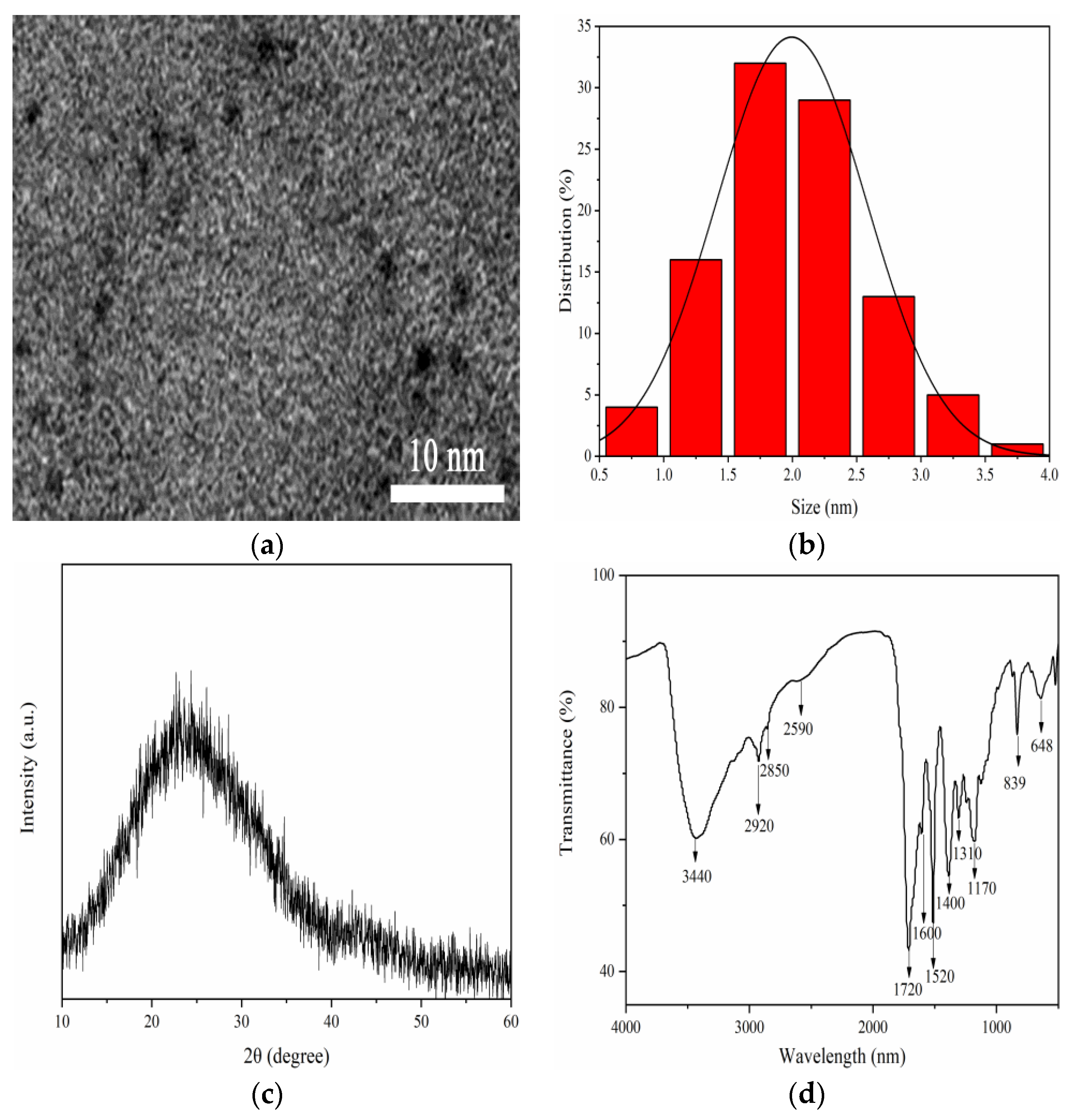
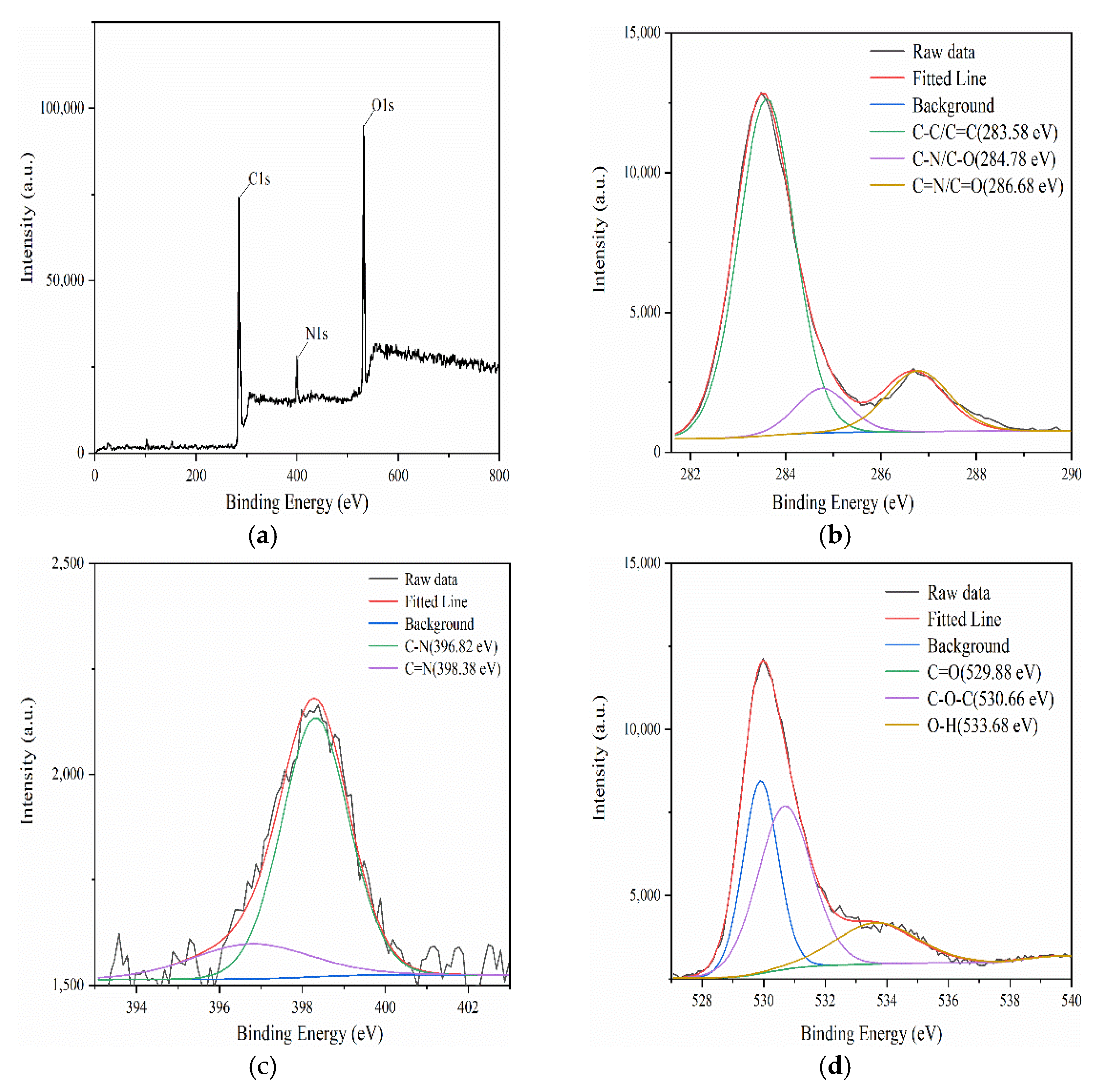

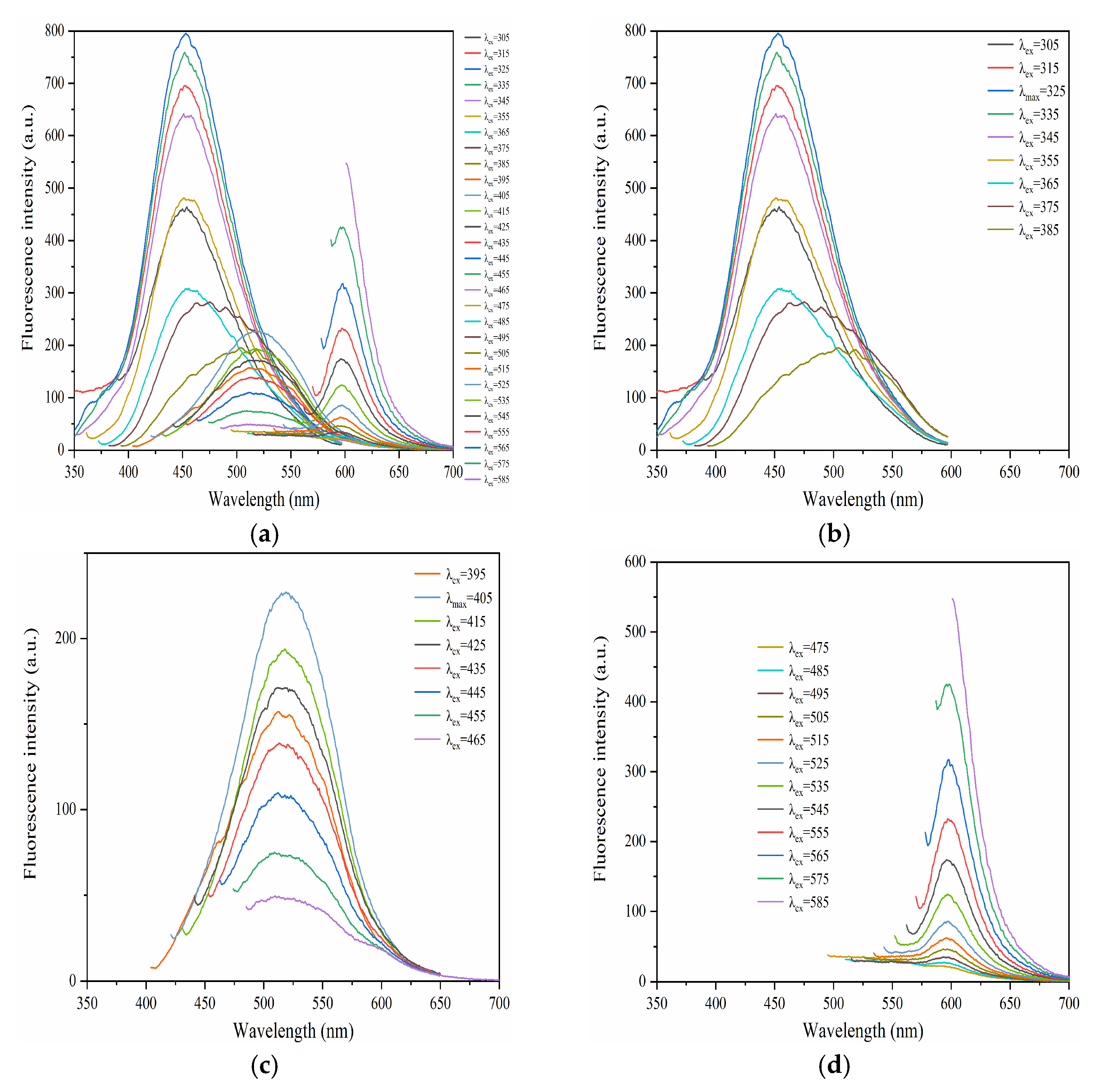
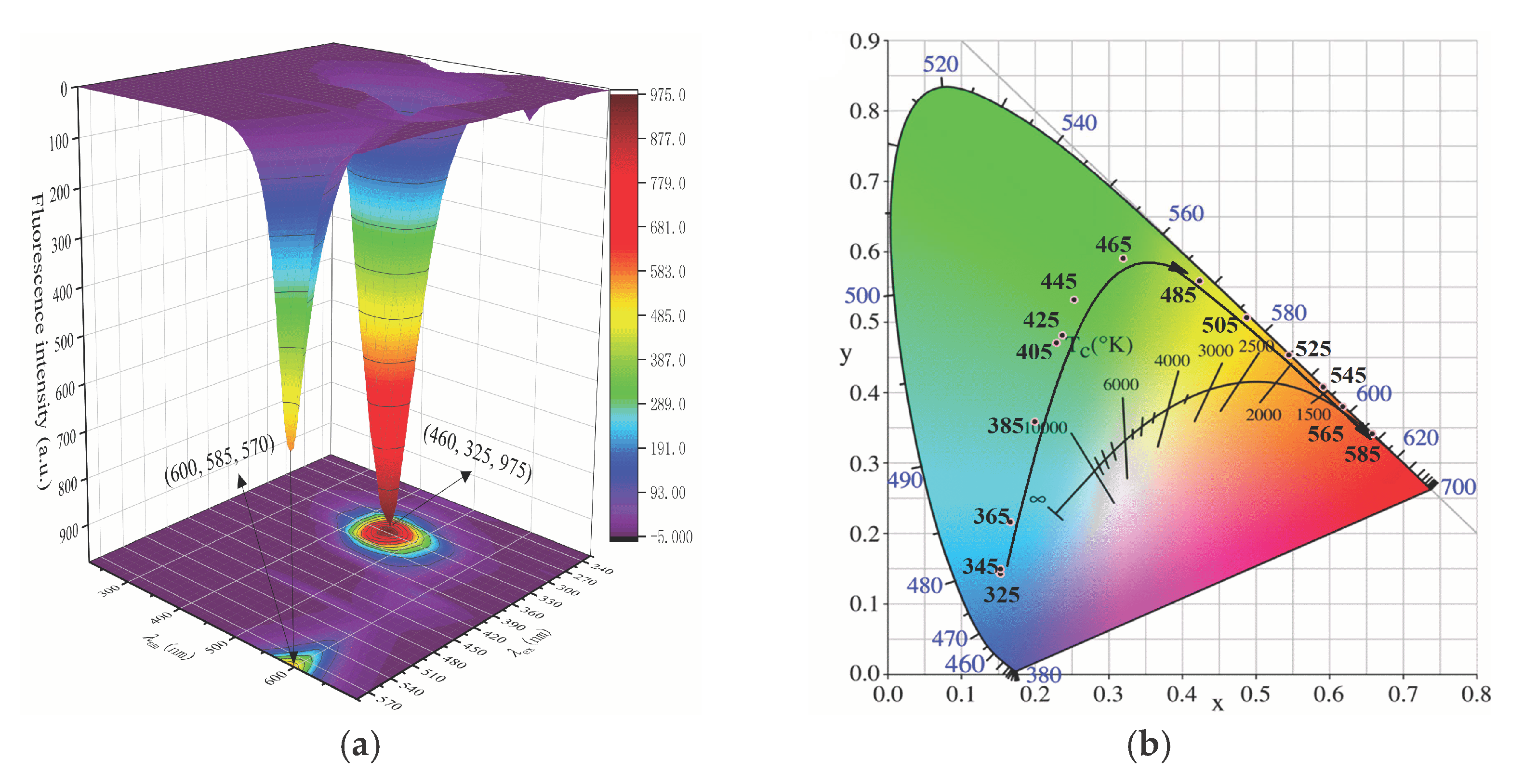

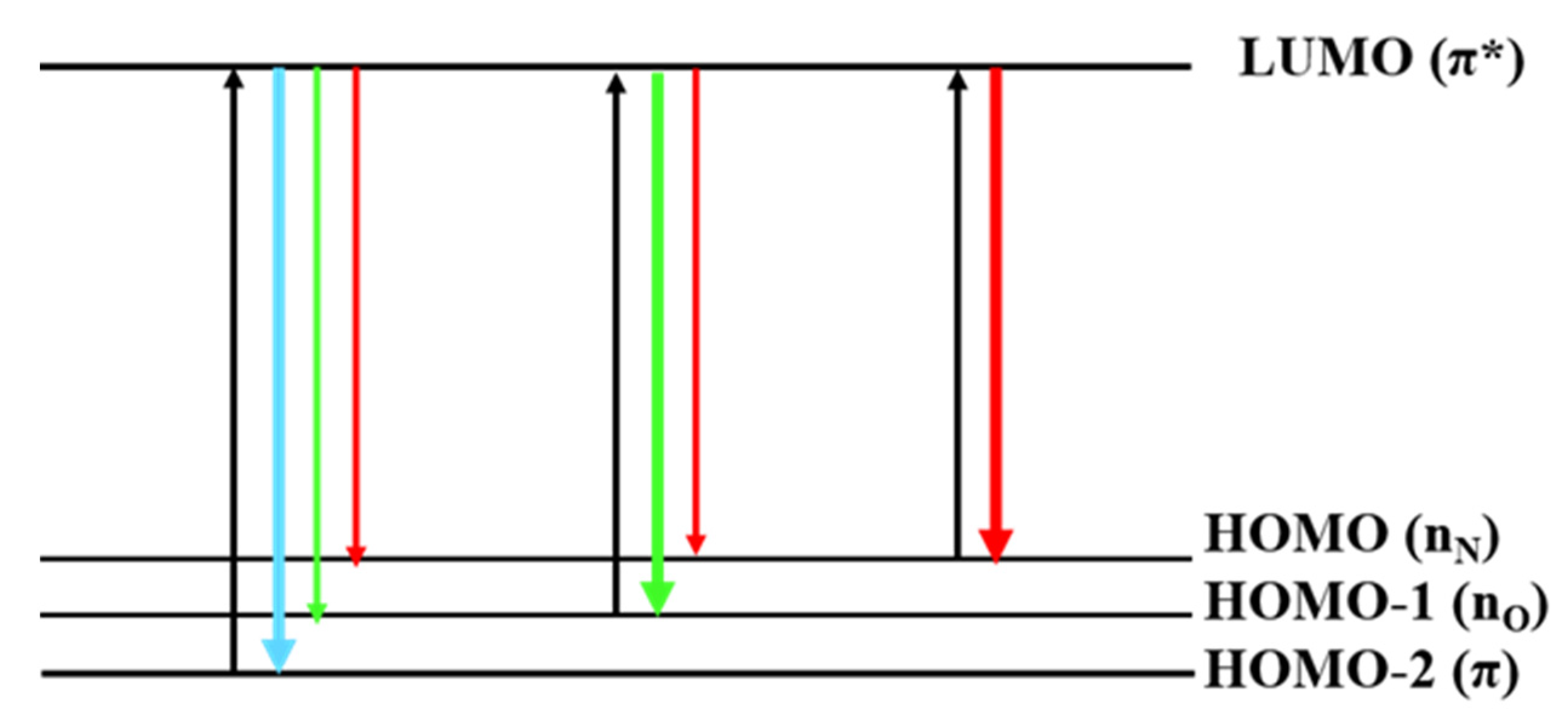

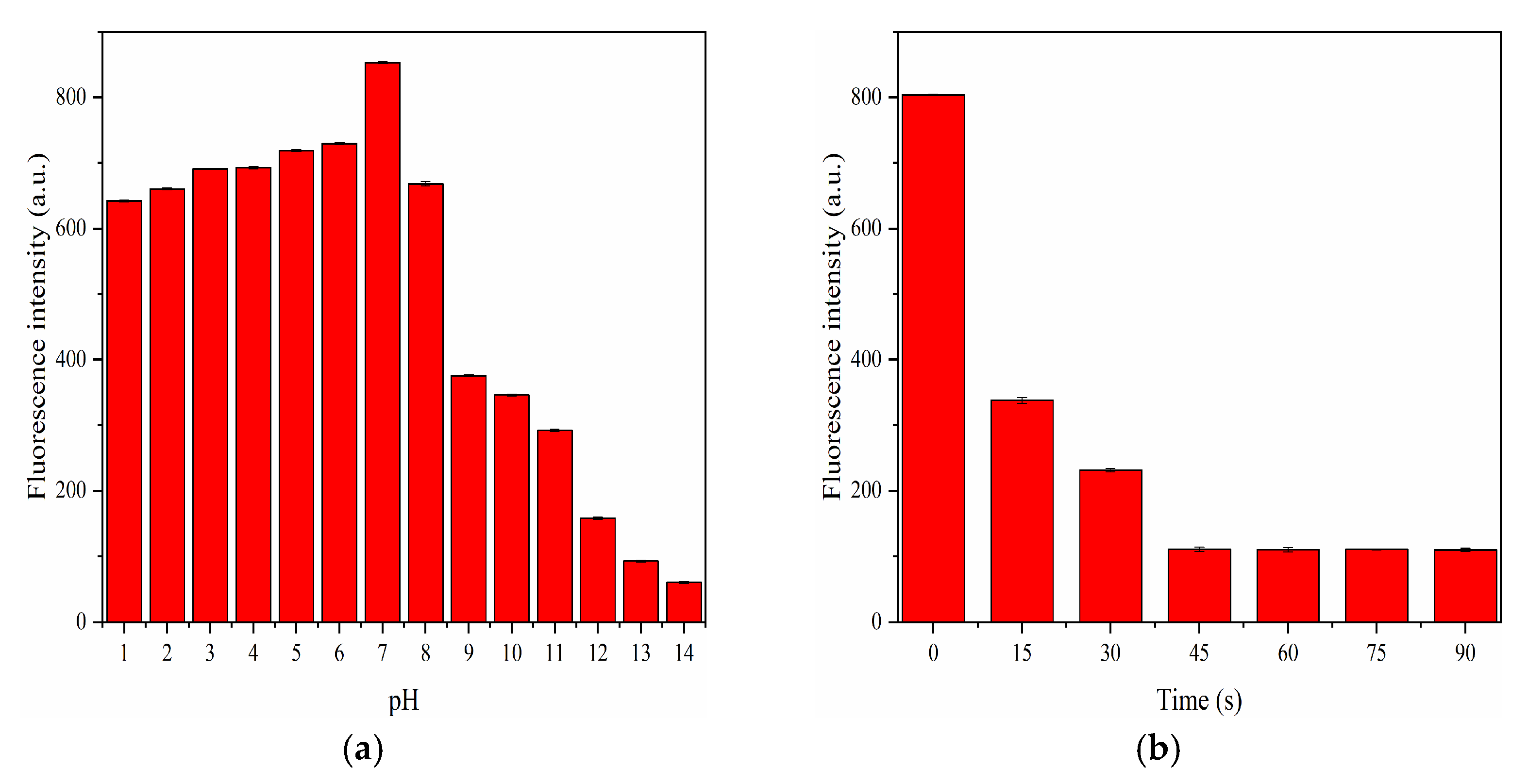
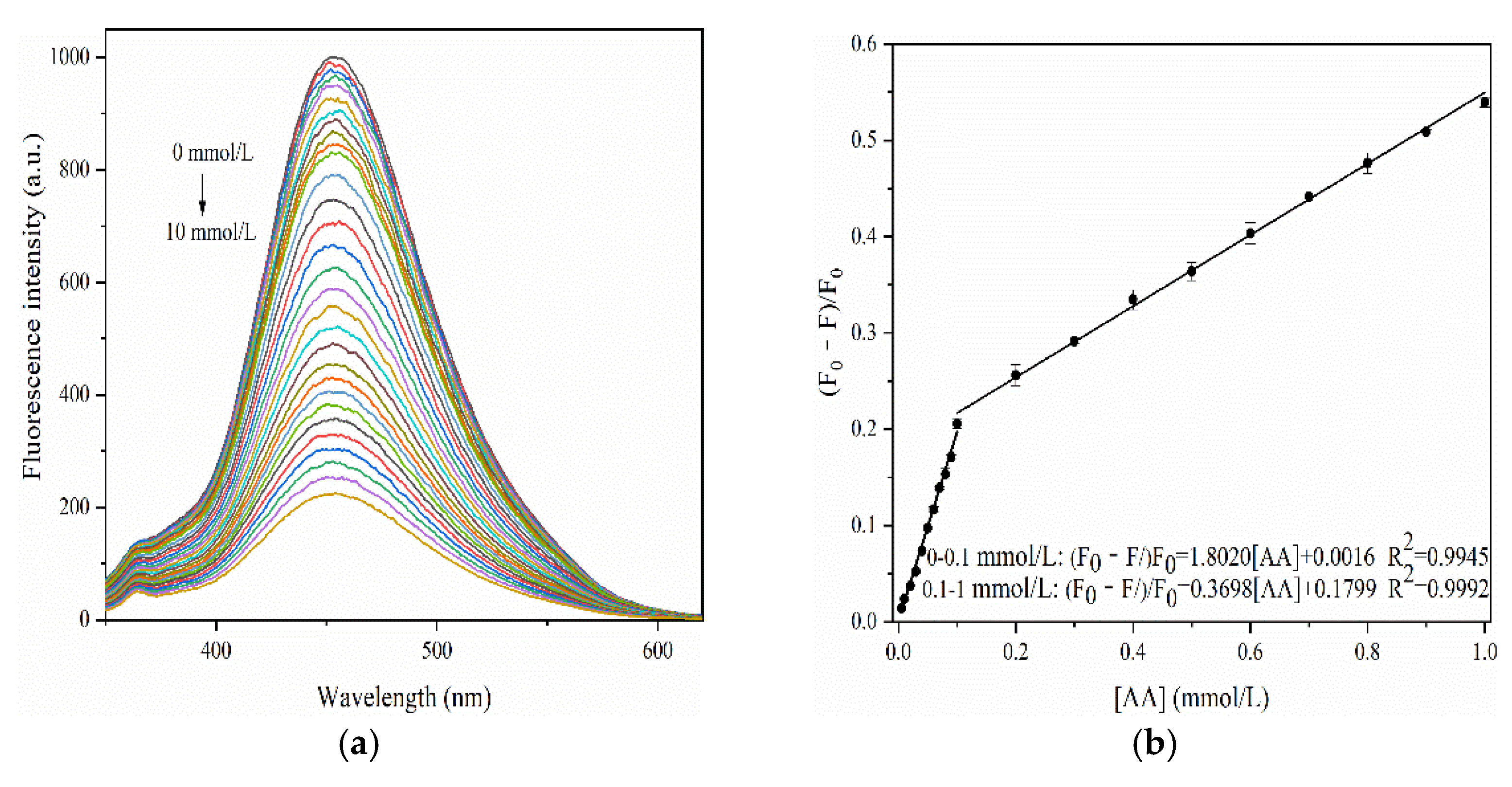

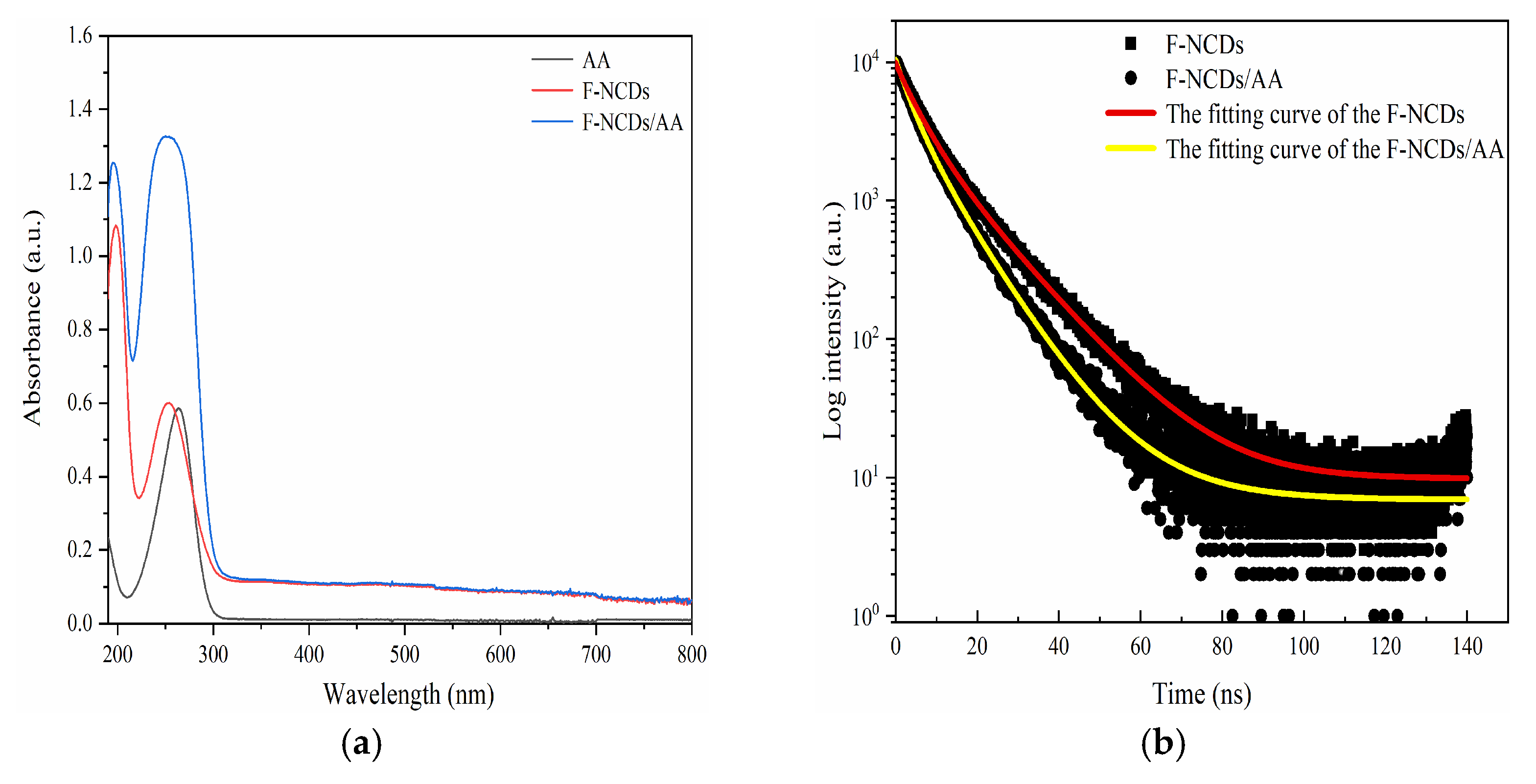
| λex/nm | λem/nm | △λ/nm | Fluorescence Intensity | x | y |
|---|---|---|---|---|---|
| 325 | 452 | 127 | 795 | 0.1533 | 0.1425 |
| 345 | 455 | 110 | 642 | 0.1533 | 0.1487 |
| 365 | 466 | 101 | 431 | 0.1662 | 0.2165 |
| 385 | 505 | 120 | 216 | 0.1995 | 0.3590 |
| 405 | 517 | 112 | 227 | 0.2287 | 0.4705 |
| 425 | 520 | 95 | 171 | 0.2370 | 0.4819 |
| 445 | 523 | 78 | 109 | 0.2537 | 0.5324 |
| 465 | 526 | 61 | 49 | 0.3203 | 0.5905 |
| 485 | 593 | 108 | 31 | 0.4242 | 0.5591 |
| 505 | 598 | 93 | 46 | 0.4880 | 0.5069 |
| 525 | 599 | 74 | 85 | 0.5449 | 0.4537 |
| 545 | 600 | 55 | 174 | 0.5920 | 0.4074 |
| 565 | 601 | 36 | 317 | 0.6192 | 0.3803 |
| 585 | 602 | 17 | 600 | 0.6584 | 0.3413 |
| Materials Used | Method | Method APPLIED | linear Range (μmol/L) | LODs (μmol/L) | Ref. |
|---|---|---|---|---|---|
| acriflavine | spectrofluorometric method | fluorometric | 11,400~56,800 | 454 | [34] |
| PAP/ZrO2NPs/CNTs/GCE | voltammetric | electrode | 1~295 | 0.35 | [35] |
| boron doped diamond | voltammetric | electrode | 18.5~370 | 5.4 | [36] |
| CoTMPyP/Sr2Nb3O10 nanocomposite | voltammetric | electrode | 50~3250 | 10.6 | [37] |
| Carbon dots | spectrofluorometric method | fluorometric | 5~50 | 3.2 | [38] |
| Carbon dots | on-off-on | fluorometric | 0~200 | 0.35 | [39] |
| Carbon dots | on-off-on | fluorometric | 5~350 | 3.11 | [40] |
| Carbon dots | spectrofluorometric method | fluorometric | 0~1000 | 0.026 | This work |
| No. | Found (μmol/L) | Added (μmol/L) | Theoretical value(μmol/L) | Measured Value (μmol/L) | Recovery (%) | RSD (%, n = 3) |
|---|---|---|---|---|---|---|
| 1 | 42.28 | 20 | 62.28 | 63.24 | 101.54 | 2.1 |
| 2 | 30 | 72.28 | 72.20 | 99.89 | 0.5 | |
| 3 | 40 | 82.28 | 82.63 | 100.43 | 1.1 |
Publisher’s Note: MDPI stays neutral with regard to jurisdictional claims in published maps and institutional affiliations. |
© 2022 by the authors. Licensee MDPI, Basel, Switzerland. This article is an open access article distributed under the terms and conditions of the Creative Commons Attribution (CC BY) license (https://creativecommons.org/licenses/by/4.0/).
Share and Cite
Huang, D.; Qi, H.; Jing, J.; Sami, R.; Jing, T.; Alsufyani, S.J.; Benajiba, N.; Madkhali, N. A Continuously Tunable Full-Color Emission Nitrogen-Doped Carbon Dots and for Ultrasensitive and Highly Selective Detection of Ascorbic Acid. Nanomaterials 2022, 12, 693. https://doi.org/10.3390/nano12040693
Huang D, Qi H, Jing J, Sami R, Jing T, Alsufyani SJ, Benajiba N, Madkhali N. A Continuously Tunable Full-Color Emission Nitrogen-Doped Carbon Dots and for Ultrasensitive and Highly Selective Detection of Ascorbic Acid. Nanomaterials. 2022; 12(4):693. https://doi.org/10.3390/nano12040693
Chicago/Turabian StyleHuang, Demin, Haiyan Qi, Jing Jing, Rokayya Sami, Tao Jing, Sultan J. Alsufyani, Nada Benajiba, and Nawal Madkhali. 2022. "A Continuously Tunable Full-Color Emission Nitrogen-Doped Carbon Dots and for Ultrasensitive and Highly Selective Detection of Ascorbic Acid" Nanomaterials 12, no. 4: 693. https://doi.org/10.3390/nano12040693






